Joining up the dots
Sue McGarrigle ND DipION NTC CNHC MBANT
Since becoming a naturopath I have always stuck to some very simple but very fundamental principles. Deep refreshing sleep, walking, an abundance of traditional native foods, relaxation and quiet once a day, good hydration and time to eat and chew properly.
We are all faced with clients who do not have, do not know how or do not have the inner strength to achieve one or more of these standard human functions which the body uses in its ability to maintain health. Load into this our frustrations at our clients ‘Grab and Go’ lifestyles punctuated with ad hoc use of minor drugs which potentially spiral into stronger usage and an underlying lack of immune and gut function we then have to work very hard to produce the expected ‘instant return to health’.
In this the pharmaceutical approaches of drugs which may provide instant relief of symptoms are against us and also can make prescribing a difficult task particularly when using the more pharma approach of isolated nutrients at varying dosages. The ancient (actually naturopaths) of their time had it ‘cracked’ using a wide variety of garden herbs and traditional foods (some of which are the base of our medicines today) to help people with a lot of health problems that we still see. Nothing changes much does it? Only that we have gone through massive changes biologically, genetically and in food intake in a relatively short span of time. Have we caught up or adapted?
In looking at some of our foods in depth recently and reading what scientists ‘latest research’ is discovering about these foods but, which was always there tucked away in the seeds, rinds, leaves, oils and roots I am always in awe of the power our food has to not only alleviate symptoms but keep us free from disease. Isn’t that obvious? It is the core of nutrition. We evolved to use these tools. Antibiotic resistance and the mutation of microbes is just one element where certain foods may be needed to come back ‘into their own’.
Garlic is one such food with its own smelly weapons activated as a result of insects invading its outer coat, its volatile oil with its sulphurous components having been part of our own arsenal to maintain microbial balance in the gastro-intestinal tract for thousands of years. There are harsh other natural anti-microbial agents which can be used and are recommended but for me they fall short, I think it is important that we use natural whole foods which contribute to the correction of dysbiosis without affecting our crucial commensals or beneficial microflora.
Garlic and Cinnamon are but two which can help to achieve this. In this day and age it is vital to maintain gut homeostasis and good immunity which are pretty much at the base of most diseases and inflammation. The microbiologists have swung a spotlight on T-cell regulation and oral tolerance with recent landmark papers giving more insight into the complicated microbial world (of which we know little) to some of the unknown but far reaching effects our microflora have in distal organs and certain diseases including Multiple Sclerosis.
Looking at the list of pathogens including antibiotic resistant strains that researchers have confirmed have a susceptibility to Garlic’s raw compounds is pretty extensive and to my mind extremely protective and therapeutic where needed. From 5000 years ago it has been a staple used by the Chinese, the Egyptians, the Romans, the Greeks right through to the Second World War. Louis Pasteur demonstrated, in 1858, that garlic could kill infectious germs. Albert Schweizer, in the early and mid-20th century, used garlic in Africa to cure typhoid fever and cholera.
Garlic was used throughout World War I to treat battle wounds and to cure dysentery. During World War II, garlic was known as "Russian penicillin" because it was so effective in treating wound infections when adequate antibiotics were not available. Apart from which let’s not forget its other multiple benefits in CVD, in maintaining urinary and prostate health, respiratory health, immune health, liver and kidney health, aiding against the common cold, flu, fatigue and in certain cancers. Interestingly, as one
example, in China, a study comparing populations in different regions found that death from gastric cancer in regions where garlic consumption was high was significantly less than in regions with lower garlic consumption.
You W. C. et al., Allium vegetables and reduced risk of stomach cancer, J Natl Cancer Inst, 1989, 81, pp 162-164
• A lot of people put Rosemary into their Sunday roast with the joint of lamb just for
that extra flavour, but probably in the unwitting knowledge that it is going to
aid the digestion of the meat and help with dyspepsia which I find is quite
prevalent in a lot of clients these days due to a variety of modern
causes. Paracelsus, the renowned 16th century herbalist valued rosemary oil which he believed had the ability to heal organs such as the liver, heart and brain. Three of Rosemary’s components in particular carnosic acid, carnosol and rosemarinic acid are powerful antioxidants and anti-inflammatory agents against lipid peroxidation,
superoxide anion and lipid rancidity. Masuda T et al. J Agric Food Chem 2002;50(21):5863-5869 Carnosol has been found to down regulate NFKappa B a nuclear transcription factor which is involved in inflammation. Cheung S, Tai J. Anti-proliferative and antioxidant properties of rosemary Rosmarinus officinalis. Oncol Rep.
2007 Jun;17(6):1525-3.Traditionally Rosemary is associated with the word ‘remembrance’, studies have examined rosemary's potential role in cognitive enhancement, conducive to its longstanding reputation as a memory enhancer. One mJapanese study demonstrated that carnosic acid significantly enhances the synthesis of Nerve Growth Factor (NGF), which is vital for the growth and functional maintenance of the central nervous system.Kosaka K, Yokoi T. "Carnosic acid, a component of rosemary (Rosmarinus officinalis L.),
promotes synthesis of nerve growth factor in T98G human glioblastoma cells." Biol Pharm Bull. 2003 Nov;26(11):1620-2. More recently 1,8-cineole, one of rosemary's
main chemical components was found to improve speed and accuracy in cognitive
performance in a study at Northumbria University in 2012.In supporting the brain against free radical damage and inflammation this can only contribute to brain health and reduce risks in certain disorders which affect the brain.
Again let’s not forget the hepatoprotective role it can also play alongside maintaining certain aspects for good kidney function, its antimicrobial activity and its ability to prevent the breakdown of acetylcholine.Thyme a perennial garden herb that has been employed since ancient times for medicinal and culinary uses was used as incense in Greek temples. The Egyptians also used it in embalming. In the Middle Ages it was given to jousting knights for courage, and a sprig of the herb was carried to ward off diseases. Since the 16th century, thyme oil has been used for its antiseptic properties and is another member of the venerable Lamiaceae, mint family and has a long history of use in natural medicine particularly
chest and respiratory problems including coughs, bronchitis, and lung congestion. It acts as an expectorant, stimulates mucous membrane health in the lungs and calms coughing spasms. The components in thyme that promote its healing effects include its volatile oil components of which thymol a potent anti-oxidant is a principle. Arzneimittelforschung. 2007;57(9):607-15.Evaluation of








